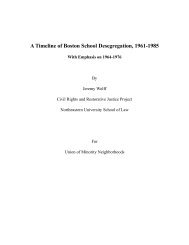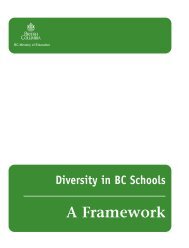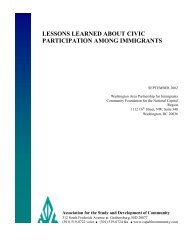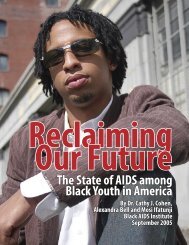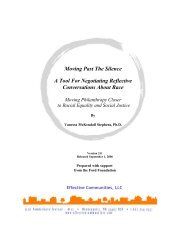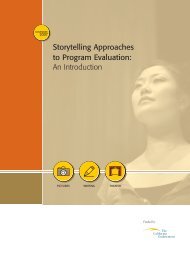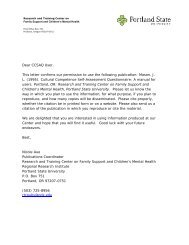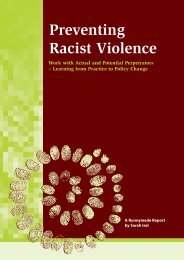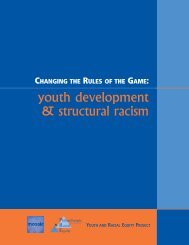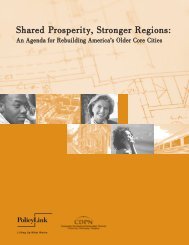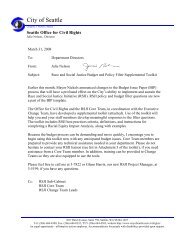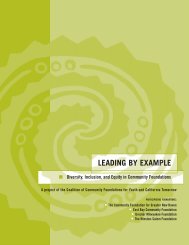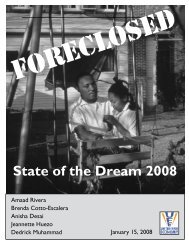REGIONAL OPPORTUNITYContact PeopleCass<strong>and</strong>ra Benjam<strong>in</strong>Senior Program OfficerCharles <strong>and</strong> Helen Schwab Foundationcbenjam<strong>in</strong>@schwabfoundation.org(650) 655-2211Vera de VeraDirector, Western <strong>Regional</strong> OfficeFannie Mae Foundationvdevera@fanniemaefoundation.org(626) 396-5370Radhika K. FoxSenior Program AssociatePolicyL<strong>in</strong>kradhika@policyl<strong>in</strong>k.org(510) 663-4324Doug ShoemakerDeputy DirectorNon-Pr<strong>of</strong>it Hous<strong>in</strong>g Association <strong>of</strong> NorthernCalifornia (NPH)doug@nonpr<strong>of</strong>ithous<strong>in</strong>g.org(415) 989-8160Dianne Spauld<strong>in</strong>gExecutive DirectorNon-Pr<strong>of</strong>it Hous<strong>in</strong>g Association <strong>of</strong> NorthernCalifornia (NPH)dianne@nonpr<strong>of</strong>ithous<strong>in</strong>g.org(415) 989-8160III. B. ENSURING A FAIR FARE:TRANSIT ADVOCACY INDIVERSE REGIONSFunders Highlighted:Catholic Campaign for Human DevelopmentAlfred P. Sloan Foundation“People are generally underst<strong>and</strong><strong>in</strong>g <strong>of</strong> the needfor <strong>in</strong>creased revenues. They are not look<strong>in</strong>g for afree ride—just a fair one.”— Beat the Fare Increase Campaign, BostonFaced with budget shortfalls, transit agencies acrossthe nation have raised fares, reduced the frequency <strong>of</strong>service, elim<strong>in</strong>ated routes, delayed capital projects,<strong>and</strong> implemented hir<strong>in</strong>g freezes <strong>and</strong> staff reductions. 45The transit agencies <strong>of</strong> New York City, Boston, <strong>and</strong>Baltimore have pursued some <strong>of</strong> these options. Thesemeasures have disparate, negative impacts on transitdependentriders, particularly low-<strong>in</strong>come <strong>and</strong>m<strong>in</strong>ority communities. This pr<strong>of</strong>ile looks at funders<strong>and</strong> community organizations who have addressedthis <strong>in</strong>creas<strong>in</strong>gly common regional transit equity issue<strong>in</strong> New York, Massachusetts, <strong>and</strong> Maryl<strong>and</strong>.Project Pr<strong>of</strong>ileNew York CityThe Metropolitan Transportation Agency (MTA), anagency <strong>of</strong> the state <strong>of</strong> New York, is the parentorganization <strong>of</strong> New York City Transit. MTA NewYork City Transit is the largest agency <strong>in</strong> the MTAregional transportation network, which also <strong>in</strong>cludesMTA Staten Isl<strong>and</strong> Railway (part <strong>of</strong> NYC Transit’sDepartment <strong>of</strong> Subways), MTA Long Isl<strong>and</strong> RailRoad, MTA Long Isl<strong>and</strong> Bus, MTA Metro-NorthRailroad, MTA Bridges <strong>and</strong> Tunnels, <strong>and</strong> MTACapital Construction. In 2002, the MTA proposedrais<strong>in</strong>g its base fare from $1.50 to $2.00, rais<strong>in</strong>g theprice <strong>of</strong> its “unlimited ride” passes, <strong>and</strong> reduc<strong>in</strong>gservices. The MTA proposed this <strong>in</strong>crease, its firsts<strong>in</strong>ce 1995, because <strong>of</strong> a claimed $2 billion operat<strong>in</strong>gdeficit. This fare <strong>in</strong>crease was opposed by theStraphangers Campaign.45A recent annual survey by the American Public TransportationAssociation showed that 90 percent <strong>of</strong> large transit agencies hadimplemented fare <strong>in</strong>creases <strong>and</strong> 35 percent <strong>of</strong> all agencies were reduc<strong>in</strong>gfrequency <strong>of</strong> service.95Funders’ Network for Smart Growth <strong>and</strong> Livable Communities
The Straphangers Campaign was founded <strong>in</strong> 1979 bythe New York Public Interest Research Group(NYPIRG), which serves as an advocate for the almostseven million daily users <strong>of</strong> the New York City transitsystem (buses, subways). Previous Straphanger effortsresulted <strong>in</strong> free subway-bus transfers <strong>and</strong> the abovementioned“unlimited ride” passes. Importantly, theStraphangers had a strong record <strong>of</strong> analyz<strong>in</strong>g MTAdata <strong>and</strong> us<strong>in</strong>g that data to produce numerous reportson the quality <strong>of</strong> the New York City transit system.Straphangers’ personnel (some <strong>of</strong> whom have workedfor the group for over 20 years) have significantexperience review<strong>in</strong>g MTA budgets, but could notidentify exactly where the claimed shortfall orig<strong>in</strong>ated.Doubt<strong>in</strong>g the accuracy <strong>of</strong> the MTA’s projections, <strong>in</strong>late 2002, the Straphangers wrote the Comptroller forthe state <strong>of</strong> New York <strong>and</strong> the Comptroller for NewYork City to express the group’s concerns <strong>and</strong> torequest that each <strong>of</strong>fice audit the MTA.In April 2003, the audits were released, f<strong>in</strong>d<strong>in</strong>g thatthe MTA exaggerated its 2003 operat<strong>in</strong>g deficit byshift<strong>in</strong>g $500 million <strong>in</strong> revenue forward to 2004. Inresponse, the Straphangers <strong>and</strong> other groups filed suitaga<strong>in</strong>st the MTA. After an <strong>in</strong>itial victory at the NewYork State Supreme Court, the Straphangers groupwas defeated <strong>in</strong> two subsequent appeals—the lattertak<strong>in</strong>g place <strong>in</strong> August 2003. This loss, comb<strong>in</strong>edwith the MTA’s May 2003 approval <strong>of</strong> the proposedfare <strong>in</strong>crease, effectively ended the Straphangers’effort to block the 2003 fare <strong>in</strong>crease. Still, theStraphangers achieved a number <strong>of</strong> successes, mostlyby way <strong>of</strong> enhanc<strong>in</strong>g access to the MTA’s budget<strong>in</strong>gprocess. Whereas the MTA ord<strong>in</strong>arily released anannual budget <strong>in</strong> November <strong>and</strong> voted on it <strong>in</strong>December, budgets are now more regularly released<strong>and</strong> five-year projections are now available.This new, greater transparency proved important as itenabled the Straphangers to anticipate <strong>and</strong> respond toanother proposed fare <strong>in</strong>crease <strong>in</strong> mid-2004. Then,the MTA proposed to raise fares on passes <strong>and</strong><strong>in</strong>itially proposed some significant service reductions.S<strong>in</strong>ce that proposal, Straphangers’ efforts have focusedon stopp<strong>in</strong>g the <strong>in</strong>crease, as well as turn<strong>in</strong>g attentionto state level decisions which impact transit fund<strong>in</strong>g.BostonMeanwhile, <strong>in</strong> Massachusetts, the Massachusetts BayTransportation Authority (MBTA) operates thecountry’s oldest subway system <strong>and</strong> servesapproximately 600,000 customers with 1.2 milliontrips a day. In 2004, the MBTA proposed to <strong>in</strong>creasebus fares from $0.75 to $1.00 <strong>and</strong> to <strong>in</strong>crease subwayfares from $1.00 to $1.25. This followed a similar<strong>in</strong>crease <strong>in</strong> 2001-2002. Before 2001-2002, theMBTA had not <strong>in</strong>creased fares s<strong>in</strong>ce 1990-1991.In response, a campaign known as Beat the FareIncrease was formed by two Boston-area groups: theTransit Riders Union (TRU) <strong>and</strong> On the Move:Greater Boston Transportation Justice Coalition(Coalition). A strategy committee—composed <strong>of</strong>Alternatives for Community & Environment (ACE, afound<strong>in</strong>g member<strong>of</strong> the Coalition),Bowdo<strong>in</strong> StreetHealth Center,Conservation LawFoundation,Egleston SquareNeighborhoodAssociation, FourCorners ActionCoalition,MassachusettsPublic InterestResearch Group(MASSPIRG), Sierra Club, TRU, <strong>and</strong> the“As fares <strong>in</strong>crease, ridershipdecreases because morepeople with cars will chooseto drive … [leav<strong>in</strong>g] therema<strong>in</strong><strong>in</strong>g transit riders toshoulder the cost <strong>of</strong> a moreexpensive system.”— Beat the Fare IncreaseWash<strong>in</strong>gton Street Corridor Coalition—reached outto the community <strong>and</strong> planned <strong>and</strong> implemented thecampaign. The campaign divided its goals <strong>in</strong>to fourareas: Public Review, Clean Air, Revenue, <strong>and</strong>Stopp<strong>in</strong>g the Fare Increase.Beat the Fare Increase literature noted that, “As fares<strong>in</strong>crease, ridership decreases because more peoplewith cars will choose to drive … [leav<strong>in</strong>g] therema<strong>in</strong><strong>in</strong>g transit riders to shoulder the cost <strong>of</strong> amore expensive system.” In effect, it argued, “Thisfare <strong>in</strong>crease represents another tax on work<strong>in</strong>gpeople, <strong>and</strong> an unfair tax,” because the fare <strong>in</strong>creasegreatly exceeded broader <strong>in</strong>creases <strong>in</strong> the cost <strong>of</strong>liv<strong>in</strong>g <strong>and</strong> gasol<strong>in</strong>e (approximately 40 percent s<strong>in</strong>ce1990). This led the campaign to charge another<strong>in</strong>equity, a “cont<strong>in</strong>ued policy <strong>of</strong> subsidiz<strong>in</strong>g drivers ata much higher rate than public transit riders.”The Beat the Fare Increase campaign dem<strong>and</strong>ed:• The MBTA to take all steps to <strong>in</strong>crease non-farerevenues before rais<strong>in</strong>g fares;• An Automated Fare Collection system that willprovide accurate ridership counts, a basis forsound account<strong>in</strong>g, fiscal plann<strong>in</strong>g, <strong>and</strong> systemREGIONAL OPPORTUNITYPart III: Section 3: Connect<strong>in</strong>g to <strong>Regional</strong> Opportunity 96
- Page 1 and 2:
Stories of Philanthropic Leadership
- Page 3 and 4:
Signs of Promise:Stories of Philant
- Page 5 and 6:
Funders’ Network for Smart Growth
- Page 7 and 8:
(II. B.)(II. C.)Turning Neighborhoo
- Page 9 and 10:
PART I:IntroductionThe Purpose of t
- Page 11 and 12:
social justice issues as they relat
- Page 13 and 14:
PART II:Perspectives on Advancing R
- Page 15 and 16:
peer work, we can reestablish a sig
- Page 17 and 18:
Annie E. Casey FoundationBaltimore,
- Page 19 and 20:
neighborhoods into healthy ones—g
- Page 21 and 22:
Charles and Helen Schwab Foundation
- Page 23 and 24:
Section 1:Promoting Equitable Publi
- Page 25 and 26:
I. A. BUILDING POWER AND GIVINGVOIC
- Page 27 and 28:
policy advocates. In 2002, Milwauke
- Page 29 and 30:
in Los Angeles, Ford’s Anthony no
- Page 31 and 32:
I. B. PROMOTING COALITIONSTO ADVANC
- Page 33 and 34:
Yet the interpersonal dynamics of c
- Page 35 and 36:
guidelines. “Many of the member o
- Page 37 and 38:
Funder InterestThe EPA supported th
- Page 39 and 40:
I. D. DEMONSTRATING THESTRUGGLE FOR
- Page 41 and 42:
Richmond, Calif.The second regional
- Page 43 and 44:
through policy reform at the local
- Page 45 and 46:
I. E. BUILDING COALITIONTHROUGH KNO
- Page 47 and 48:
organizing project, the Connecticut
- Page 49 and 50:
and businesses are quantified in a
- Page 51 and 52: I. G. REVITALIZING WHILEASSURING DI
- Page 53 and 54: In the late 1990s, the city of Albu
- Page 55 and 56: I. H. A TRAVEZ DE LA FRONTERA:LAND
- Page 57 and 58: The International Community Foundat
- Page 59 and 60: I. I. MOBILIZING ACTION FORREGIONAL
- Page 61 and 62: To meet all of these objectives, th
- Page 63 and 64: efforts. And with each public plann
- Page 65 and 66: pattern of disproportionate transpo
- Page 67 and 68: Clinica de la Raza identify this cr
- Page 69 and 70: Contact PeopleCarl AnthonyActing Di
- Page 71 and 72: Section 2:Making All Neighborhoods
- Page 73 and 74: II. A. REACHING BEYONDHOUSING TO IM
- Page 75 and 76: A local resident receives the keys
- Page 77 and 78: East Baltimore community and the Jo
- Page 79 and 80: example, adjacent to the EBDI area,
- Page 81 and 82: II. C. YIELDING REGIONALBENEFITS TH
- Page 83 and 84: is using transit-oriented developme
- Page 85 and 86: financing and innovative, forward-t
- Page 87 and 88: The Row House Community Development
- Page 89 and 90: II. E. COUNTERING THE PERFECTSTORM:
- Page 91 and 92: funded community programs, includin
- Page 93 and 94: housing developments and commercial
- Page 95 and 96: owned enterprises, totaling $8.5 mi
- Page 97 and 98: LOAN GUARANTEESSection 3:Connecting
- Page 99 and 100: III. A. MAKING HOUSING ANOPPORTUNIT
- Page 101: A new report from the National Hous
- Page 105 and 106: Funder InterestThe Straphangers Cam
- Page 107 and 108: or increase poverty. Whether direct
- Page 109 and 110: The Regional Plan Association then
- Page 111 and 112: multi-stakeholder effort composed o
- Page 113 and 114: director with LISC. No one set of s
- Page 115 and 116: 12 western Louisville neighborhoods
- Page 117 and 118: III. E. UNITING THREE STATESFOR ONE
- Page 119 and 120: increased their personal wealth by
- Page 121 and 122: summary evaluation of MSDI found th
- Page 123 and 124: method alone was strong enough to m
- Page 125 and 126: consistent body of work. The Counci
- Page 127 and 128: 3) Issues Need to be ConnectedThe f
- Page 129 and 130: PART V:Glossary of TermsThe terms d
- Page 131 and 132: Regional and neighborhood equity. A
- Page 133 and 134: Tijuana River Reserve, California:h
- Page 135 and 136: Sargent Shriver National Center on
- Page 137: 1500 San Remo Avenue • Suite 249



